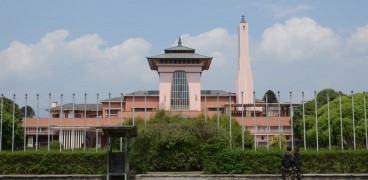Lalitpur Metropolitan City, formerly known as Patan, is Nepal's third-largest city after Kathmandu and Pokhara and is located in the south-central area inside the Kathmandu Valley. Manigal is another name for Lalitpur. It is well recognized for its rich cultural legacy, especially its arts and crafts culture.
Lalitpur is known as the city of festivals and feasts, exquisite antique art, and the sculpting of metal and stone statues. Nepal had a population of 226,728 people in 54,748 households, according to the 2011 census. On April 25, 2015, the city was severely damaged by an earthquake.
Geography of Lalitpur City
Lalitpur is located in the Kathmandu Valley, on the south bank of the Bagmati River, which divides it from the city of Kathmandu into the north and west sides. On the southern side, the Nakkhu Khola serves as a border. It grew on weak layers of deposited clay and gravel in the middle section of the Nagdaha, an ancient dried lake.
History of Lalitpur
The Kirat dynasty built Lalitpur in the third century BC, which Licchavis later extended in the sixth century. During medieval times, the Mallas enlarged it much further.

Its name has a lot of tales attached to it. The most well-known is the mythology of God Rato Machhindranath. He was transported to the valley from Kamaru Kamachhya in Assam, India, by three individuals symbolizing the three kingdoms based in the Kathmandu Valley.
One of them was Lalit, a farmer who traveled from Assam, India, to bring God Rato Machhindranath to the valley. The goal of introducing the God Rato Machhindranath to the valley was to alleviate the valley's greatest drought.
Rain would be brought to the valley by the God Rato Machhindranath, according to popular belief. The God Rato Machhindranath has settled in Lalitpur thanks to Lalit's efforts. Many people think that the town's name is derived from his surname Lalit and the word pur, which means "township."
In May, Patan hosts the Bunga Dyah Jatra, a chariot festival commemorating the god. It is one of Patan's most extended and most prominent religious festivities. A picture of Rato Machhendanath is put on a high chariot and driven around the city streets in stages throughout the month-long celebration.
Although King Veer Deva is supposed to have built Lalitpur in 299 AD, experts agree that Patan has been a well-established and developed town since ancient times. According to several historical documents and many other tales, Patan is the oldest of all the cities in the Kathmandu Valley.
According to an ancient Kirat chronicle, Patan was created by Kirat kings long before the Licchavi rulers entered the political scene in Kathmandu Valley. Thankot was the oldest known capital of Kirat kings, according to that chronicle. After the Kirati King Yalamber came to power somewhere in the second century AD, Kathmandu, the current capital, was most likely relocated from Thankot to Patan.
Yala is a common and traditional Newar name in Lalitpur. According to legend, King Yalamber or Yellung Hang named this city after himself, and it has been known as Yala ever since.
Prithvi Narayan Shah annexed Lalitpur to the Gorkha Kingdom without a fight in 1768.
Historical Monuments Found in Lalitpur
The city was planned in the shape of a Buddhist Dharma-Chakra at first (Wheel of Righteousness). The four thurs or mounds encircling Patan's perimeter, one at each of its cardinal points, are known as Asoka Stupas.
According to tradition, Emperor Asoka (the legendary King of India) visited Kathmandu around 250 BC with his daughter Charumati and constructed five Asoka Stupas, four in the Patan and one in the center. These stupas' size and shape appear to exude their antiquity tangibly. In and around the city, there are about 1,200 Buddhist monuments of diverse kinds and sizes.

According to UNESCO, the city's most notable landmark is Patan Durbar Square, one of seven Monumental Zones that constitute the Kathmandu Valley's World Heritage Sites.
In 1979, the seven monument zones were included as a single site on the UNESCO World Heritage List. The Monuments Preservation Act of 1956 declares the monument zones to be safeguarded and conserved. An earthquake on April 25, 2015, severely damaged the Square.
Vihars and Bahils were used to design Lalitpur. Patan is home to 56 per cent of the valley's 295 Vihars and Bahils. The city is embellished with water conduits, stone spouts, Jaladroni (water tanks), beautiful gateways, Hindu temples, and Buddhist Vihars.
The city's attractiveness is enhanced by its architectural, cultural history, such as the royal palace, which features elaborately carved doors and windows and lovely courtyards covered with beautiful symbols. Stone, metal, clay, ivory, and other materials create such works of art. These items demonstrate the craftsmen's aesthetic brilliance, and the entire city resembles an open museum.
Places to Visit in Lalitpur
Lalitpur is known for its artistic heritage. The majority of Nepalese art is dedicated to Gods, and there are several temples and viharas. The following are some notable points of interest:
Patan Durbar Square
The palace plaza and mansion of Patan's Malla kings, today serve as a museum.
Bhaskerdev Samskarita Hiranyabarna Mahavihara
Golden Temple is a Buddhist temple in the area.
Mahabouddha Temple
1000 Buddha Temple is a replica of the Mahabodhi Temple in Bodh Gaya.
Kumbheshwar Temple
A Shiva shrine with two ponds is said to be fed by Gosaikunda's water.
Krishna Mandir
King Siddhinarsingh Malla erected one of Nepal's most magnificent stone temples in the 16th century.
Ratnakar Mahavihar
The viahara complex, also known as Ha Baha, is the formal house of the Kumari of Patan.
Patan Dhoka
One of the ancient city's historic entrances.
















